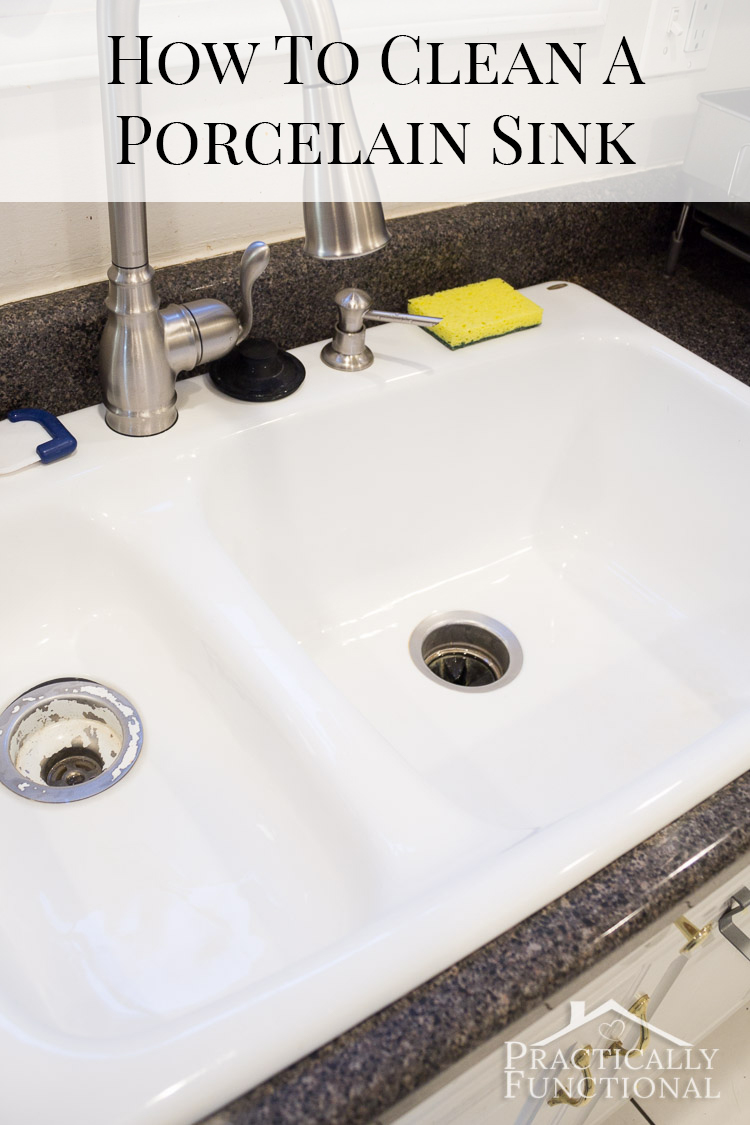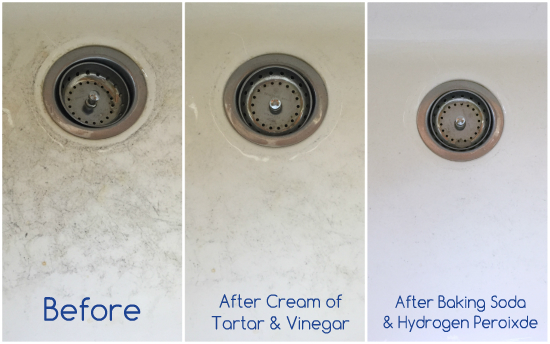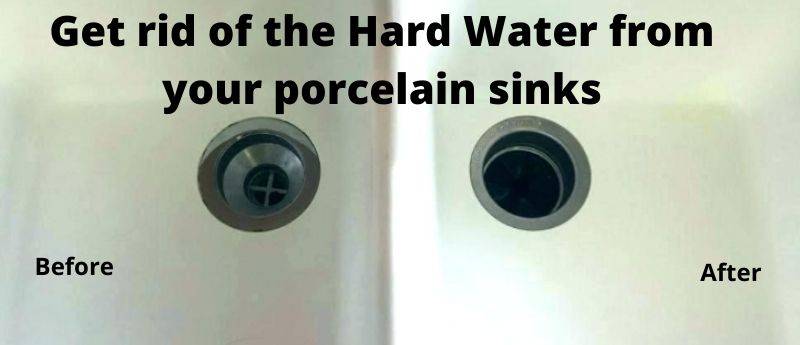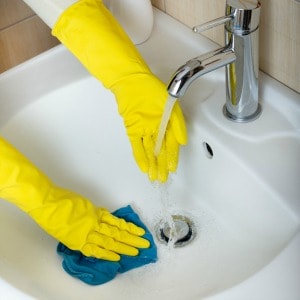Natural Stain Remover for Your Bathroom Sink
Keeping your bathroom sink clean and stain-free can be a challenge. However, there’s a powerful and natural solution right in your pantry – baking soda and vinegar. This dynamic duo can work wonders when it comes to removing stubborn stains from your bathroom sink. Let’s discuss the amazing stain-removing properties of baking soda and vinegar and how you can effectively use them to restore your sink’s sparkle.
- Baking Soda: A Gentle Abrasive Cleaner Baking soda, also known as sodium bicarbonate, is a versatile household ingredient renowned for its cleaning properties. Its fine texture makes it an excellent gentle abrasive cleaner that can effectively remove stains without scratching the sink’s surface. To use baking soda, simply sprinkle it on a damp cloth or sponge and gently scrub the stained areas of your sink. Rinse thoroughly with water, and you’ll be amazed at how effortlessly the stains disappear.
- Vinegar: A Powerful Disinfectant and Stain Remover Vinegar, particularly white vinegar, is a natural disinfectant and stain remover that can tackle even the toughest stains in your bathroom sink. Its acidic nature helps dissolve mineral deposits and soap scum, leaving your sink fresh and stain-free. To use vinegar, create a mixture of equal parts vinegar and water in a spray bottle. Spray the solution onto the stained areas of your sink, let it sit for a few minutes, and then scrub with a brush or sponge. Rinse thoroughly with water, and voila – your sink will shine like new!
- The Baking Soda and Vinegar Combination: A Stain-Fighting Powerhouse When combined, baking soda and vinegar create a powerful reaction that enhances their stain-removing abilities. This fizzy reaction helps to dislodge grime, break down stains, and eliminate odors. To use this combination, sprinkle baking soda over the stained areas of your sink, then spray vinegar over the baking soda. Allow the mixture to bubble and fizz for a few minutes before scrubbing with a brush or sponge. Rinse thoroughly with water, and you’ll be amazed at the results.
- Other Uses for Baking Soda and Vinegar in the Bathroom: In addition to removing stains from your sink, baking soda and vinegar can be used for various other cleaning tasks in your bathroom. Baking soda can freshen up your drains by pouring it down with some vinegar and hot water. It can also be used to clean grout, remove soap scum from shower doors, and deodorize your toilet. Vinegar, on the other hand, can be used to clean mirrors, faucets, and showerheads. The possibilities are endless!
- Precautions and Tips for Using Baking Soda and Vinegar: While baking soda and vinegar are safe and natural cleaning agents, it’s essential to take some precautions when using them. Avoid using them on delicate surfaces like marble or granite, as they can cause etching. Always test a small, inconspicuous area of your sink before applying the mixture to the entire surface. Additionally, make sure to properly ventilate the area as the vinegar’s strong smell can be overpowering. With these precautions in mind, you can confidently use baking soda and vinegar to remove stains and keep your bathroom sink looking fresh and clean.
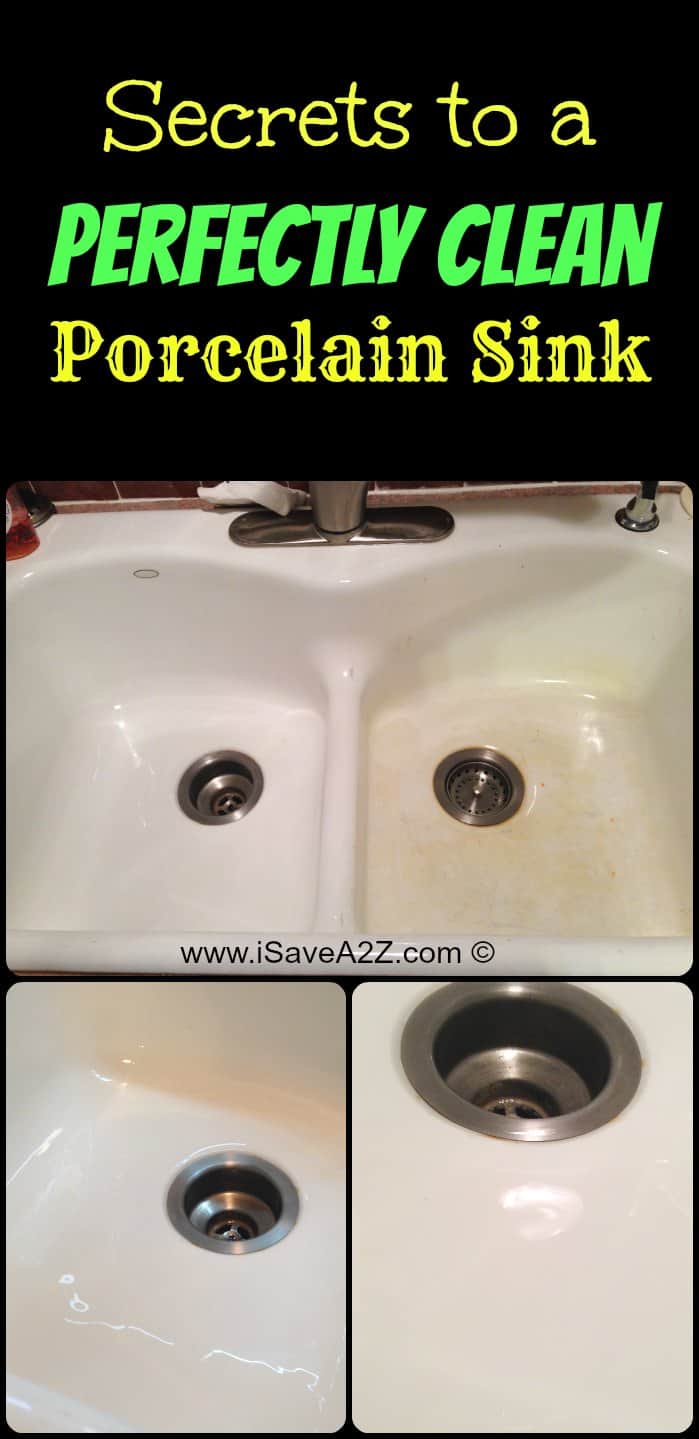
Scrub Away with Toothpaste
Toothpaste is a common household item that you probably use daily to keep your teeth clean and bright. But did you know that toothpaste can also be an effective stain remover for your bathroom sink? Let’s find out the surprising stain-removal properties of toothpaste and how you can use it to scrub away stubborn stains from your sink.
Toothpaste as a Mild Abrasive Cleaner: Toothpaste contains mild abrasives that can help remove stains and grime from various surfaces, including your bathroom sink. The gentle abrasive particles in toothpaste can scrub away stains without causing damage to the sink’s surface. To use toothpaste as a stain remover, apply a small amount of toothpaste directly to the stained area of your sink. Use a soft cloth or sponge to gently scrub the stain in circular motions. Rinse thoroughly with water, and you’ll be amazed at how effectively the toothpaste removes the stains.
Whitening Toothpaste for Stubborn Stains: If you’re dealing with stubborn stains or discoloration on your bathroom sink, consider using whitening toothpaste. Whitening toothpaste contains additional ingredients like hydrogen peroxide or baking soda that are specifically designed to remove tough stains and restore brightness. Apply a small amount of whitening toothpaste to the stained area and scrub gently with a soft cloth or sponge. Rinse thoroughly, and you’ll notice a significant improvement in the appearance of your sink.
Toothpaste for Polishing Chrome Fixtures: In addition to removing stains, toothpaste can also be used to polish chrome fixtures in your bathroom. Chrome fixtures, such as faucets and handles, can become dull and tarnished over time. Apply a small amount of toothpaste to a soft cloth or sponge and rub it onto the chrome fixtures in circular motions. The mild abrasives in toothpaste can help remove tarnish and restore the shine to your fixtures. Rinse thoroughly and buff with a clean cloth for a polished finish.
Other Uses for Toothpaste in the Bathroom: Toothpaste has a range of other practical uses in the bathroom. It can be used to remove water spots from mirrors, clean soap scum from shower doors, and even shine silverware. Additionally, toothpaste can help remove scratches from plastic surfaces, such as the outer surface of a showerhead. Its gentle abrasive properties make it a versatile cleaning agent for various surfaces in your bathroom.
Tips and Precautions for Using Toothpaste: When using toothpaste as a stain remover, it’s important to choose a non-gel toothpaste formula for best results. Gel toothpaste does not contain the same abrasive properties as regular toothpaste. Additionally, avoid using toothpaste that contains whitening agents on colored or delicate surfaces, as it may cause discoloration or damage. Always test a small, inconspicuous area of your sink before applying toothpaste to the entire surface.
Citrus Solution for a Sparkling Bathroom Sink
When life gives you lemons, don’t just make lemonade – use them to banish stains from your bathroom sink! Lemon juice is a natural and eco-friendly solution that can effectively remove stains and leave your sink sparkling clean. Let’s discuss the stain-removing properties of lemon juice and how you can harness its power to achieve a pristine bathroom sink.
The Natural Cleaning Power of Lemon Juice: Lemon juice is a powerful natural cleaner due to its acidic properties. The citric acid in lemon juice acts as a natural bleaching agent that can break down stains and remove discoloration from your sink. To use lemon juice as a stain remover, squeeze fresh lemon juice onto a soft cloth or sponge. Rub the lemon juice onto the stained areas of your sink, applying gentle pressure. Allow the juice to sit for a few minutes, then rinse thoroughly with water. The acidity of the lemon juice will help dissolve the stains and leave your sink looking refreshed.
Removing Hard Water Stains with Lemon Juice: Hard water stains are a common problem in bathroom sinks, caused by mineral deposits from the water. Lemon juice can be particularly effective in removing these stubborn stains. Cut a lemon in half and rub the cut side directly onto the hard water stains. Alternatively, you can soak a cloth or paper towel in lemon juice and place it over the stains, allowing it to sit for a few hours or overnight. The acidity of the lemon juice will help break down the mineral deposits, making it easier to scrub away the stains.
Freshening and Deodorizing with Lemon Juice: Not only does lemon juice remove stains, but it also has a pleasant and refreshing scent that can help eliminate odors in your bathroom sink. After cleaning with lemon juice, the citrus aroma will leave your sink smelling clean and fresh. Additionally, lemon juice can help neutralize and remove unpleasant smells caused by bacteria or food residue. Simply squeeze some lemon juice down the drain or mix it with water and spray it onto the sink surface to freshen up the area.
Precautions and Tips for Using Lemon Juice: While lemon juice is a natural and safe cleaning agent, it’s important to take some precautions when using it on your bathroom sink. Lemon juice is acidic and can potentially cause damage to certain surfaces, such as marble or granite. Always test a small, inconspicuous area of your sink before applying lemon juice to the entire surface. Additionally, avoid leaving lemon juice on your sink for extended periods as it may cause fading or discoloration. Rinse thoroughly with water after using lemon juice to remove stains.
Other Cleaning Uses for Lemon Juice: Lemon juice is not just limited to stain removal in the bathroom sink – it has a multitude of other cleaning uses throughout your home. It can be used to remove soap scum from shower doors, brighten grout lines, and even clean cutting boards. Its natural antibacterial properties make it a versatile and effective cleaning agent in various areas of your home.
Remove Hard Water and Rust Stains from Your Bathroom Sink
Dealing with tough stains on your bathroom sink, such as hard water and rust stains, can be a frustrating challenge. These stains can make your sink look aged and worn, even if it’s relatively new. Let’s discuss effective techniques and solutions for removing hard water and rust stains from your bathroom sink, allowing you to restore its beauty and shine.
Understanding Hard Water Stains: Hard water stains are caused by mineral deposits, typically calcium and magnesium, that are present in the water supply. Over time, these minerals can build up on your sink’s surface, leaving behind unsightly white or cloudy stains. To remove hard water stains, start by creating a mixture of equal parts water and white vinegar or lemon juice. Apply the mixture to the stained areas and let it sit for a few minutes. Then, scrub the stains using a soft brush or cloth. Rinse thoroughly with water, and repeat the process if necessary.
Banishing Rust Stains: Rust stains can occur when metal objects, such as razors or metal fixtures, come into contact with your sink’s surface and leave behind rust residue. To remove rust stains, start by creating a paste using baking soda and water. Apply the paste to the stained areas and let it sit for a few minutes. Then, scrub the stains using a soft brush or cloth. For more stubborn rust stains, you can also try using a commercial rust remover specifically designed for sinks and fixtures. Follow the manufacturer’s instructions carefully, as these products can be strong and may require proper ventilation.
Consider Using a Pumice Stone: For particularly stubborn hard water or rust stains, a pumice stone can be an effective tool. Wet the pumice stone and gently rub it on the stained areas of your sink. The abrasive properties of the pumice stone will help remove the stains without scratching the sink’s surface. It’s important to use caution when using a pumice stone, as excessive pressure or aggressive rubbing may cause damage. Always test a small area first and ensure that your sink’s surface is suitable for use with a pumice stone.
Preventing Future Stains: Once you’ve successfully removed hard water and rust stains from your bathroom sink, it’s important to take steps to prevent them from recurring. Consider installing a water softener or using a water filter to reduce the mineral content in your water supply. Regularly wipe down your sink after each use to remove any water droplets or residue that can contribute to stain formation. Additionally, avoid using harsh abrasive cleaners or scouring pads, as they can damage the sink’s surface and make it more prone to staining.
Seeking Professional Help: If you’ve tried various techniques and solutions but still can’t remove stubborn hard water or rust stains from your sink, it may be time to seek professional help. A professional cleaner or restoration service can assess the condition of your sink and provide specialized treatments to remove the stains effectively. They may use stronger chemicals or techniques that are not recommended for regular household use. Be sure to research and choose a reputable professional who has experience in dealing with sink stains.
Easy Ways to Remove Stubborn Stains from Your Sink Surface
Soap scum is a common problem in bathroom sinks, resulting from the accumulation of soap residues and minerals from hard water. Over time, it can create a dull, hazy film on the sink’s surface, making it look dirty and unappealing. Let’s explore effective methods for removing stubborn soap scum stains from your sink, allowing you to restore its cleanliness and shine.
Baking Soda and Vinegar Solution: One of the most effective and natural ways to remove soap scum from your sink is by using a combination of baking soda and vinegar. Start by sprinkling a generous amount of baking soda onto the stained areas of your sink. Then, pour vinegar over the baking soda, causing a foaming reaction. Allow the mixture to sit for a few minutes, and then scrub the surface using a soft brush or sponge. The abrasive nature of the baking soda, combined with the vinegar’s cleaning properties, will help break down the soap scum and lift it away from the sink’s surface. Rinse thoroughly with water afterward.
Citrus-Based Cleaners: Citrus-based cleaners, such as those containing natural extracts from lemons or oranges, can be highly effective in removing soap scum stains from your sink. These cleaners contain natural acids that break down the soap residue and leave a fresh citrus scent behind. Follow the instructions on the cleaner’s packaging, apply it to the stained areas of your sink, and let it sit for a few minutes. Then, scrub the surface with a soft brush or sponge and rinse thoroughly with water. The citrus cleaner will help dissolve the soap scum and restore the sink’s cleanliness.
White Vinegar Soak: If your sink has heavy soap scum buildup, a white vinegar soak can be a simple yet effective solution. Fill a basin or container large enough to accommodate the sink stopper with equal parts water and white vinegar. Place the sink stopper in the drain and pour the vinegar-water mixture into the sink, fully submerging the stained areas. Let the sink soak for several hours or overnight. The acidity of the vinegar will break down the soap scum, making it easier to scrub away. After soaking, scrub the sink with a soft brush or sponge, and rinse thoroughly with water.
Commercial Soap Scum Removers: If natural remedies don’t do the trick, you can try using a commercial soap scum remover specifically designed for bathroom surfaces. These products often contain powerful cleaning agents that can effectively dissolve and remove stubborn soap scum stains. Read and follow the instructions on the product carefully, as some may require dilution or specific application methods. Apply the soap scum remover to the stained areas, allow it to sit for the recommended amount of time, and then scrub the surface with a soft brush or sponge. Rinse thoroughly afterward.
Preventive Maintenance: To prevent soap scum buildup in the future, it’s important to practice regular maintenance and cleaning. After each use, wipe down the sink with a soft cloth or sponge to remove any soap residue or water droplets. Consider using liquid soap instead of bar soap, as it tends to leave behind fewer residues. Additionally, using a squeegee or towel to dry the sink after use can help minimize soap scum formation. Regularly cleaning your sink with gentle cleaners or natural solutions can also help prevent soap scum from accumulating.
How to Clean and Shine a Porcelain Sink: 10 Steps (with Pictures)
How To Clean A Porcelain Sink (including the stains and scuff
How To Get a Clean Porcelain Sink and Remove Rust Stains Too
How to Clean A Porcelain Sink – Lemons, Lavender, u0026 Laundry
10 ways how to Remove hard water Stains from Porcelain Sinks
Removing Hard Water Stains in Sinks – Creative Homemaking
How To Remove Rust Stains From A Porcelain Sink – YouTube
Related Posts:
- 15 X 12 Undermount Bathroom Sink
- Menards Bathroom Sink Tops
- Resin Bathroom Sinks
- Miseno Bathroom Sinks
- Antique Looking Bathroom Sink Faucets
- Color Changing Led Waterfall Widespread Bathroom Sink Faucet
- Moen Bathroom Sink Faucets Brushed Nickel
- Natural Stone Vessel Bathroom Sinks
- High Back Farmhouse Bathroom Sink
- Clogged Bathroom Sink Drano





